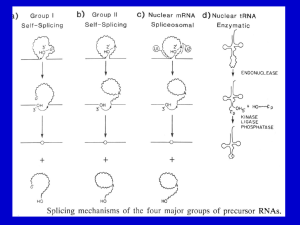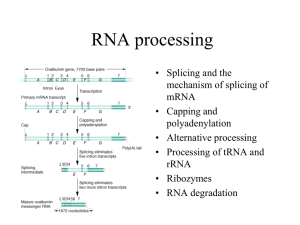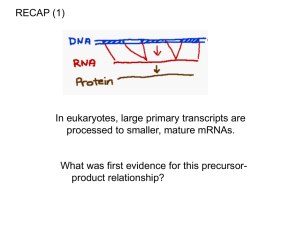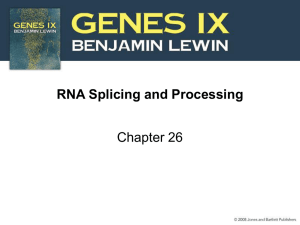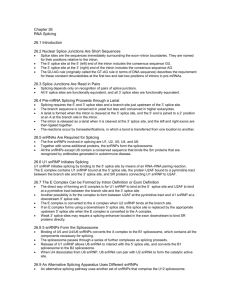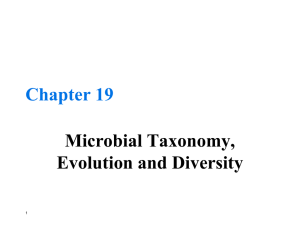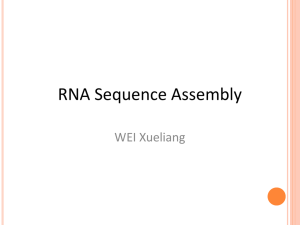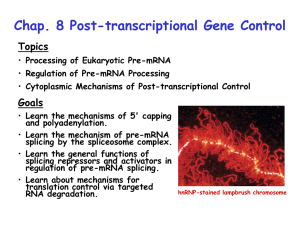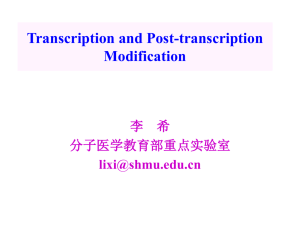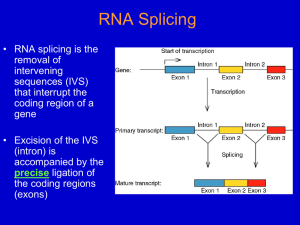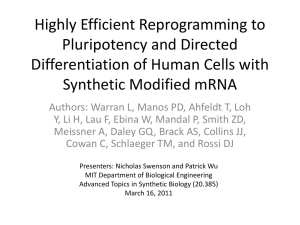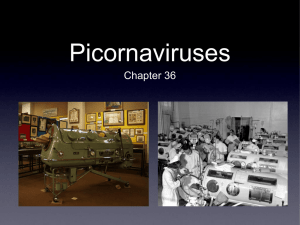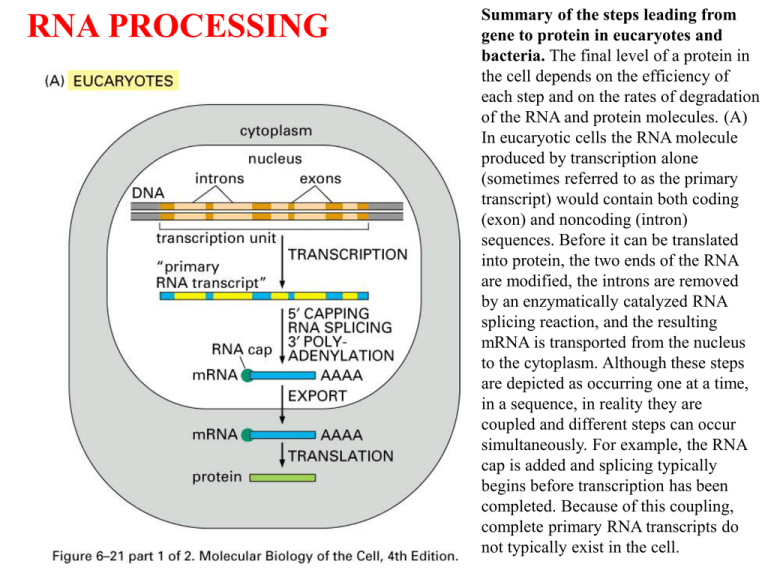
RNA PROCESSING
Summary of the steps leading from
gene to protein in eucaryotes and
bacteria. The final level of a protein in
the cell depends on the efficiency of
each step and on the rates of degradation
of the RNA and protein molecules. (A)
In eucaryotic cells the RNA molecule
produced by transcription alone
(sometimes referred to as the primary
transcript) would contain both coding
(exon) and noncoding (intron)
sequences. Before it can be translated
into protein, the two ends of the RNA
are modified, the introns are removed
by an enzymatically catalyzed RNA
splicing reaction, and the resulting
mRNA is transported from the nucleus
to the cytoplasm. Although these steps
are depicted as occurring one at a time,
in a sequence, in reality they are
coupled and different steps can occur
simultaneously. For example, the RNA
cap is added and splicing typically
begins before transcription has been
completed. Because of this coupling,
complete primary RNA transcripts do
not typically exist in the cell.
(B) In procaryotes the production of mRNA molecules is much simpler. The 5' end of
an mRNA molecule is produced by the initiation of transcription by RNA
polymerase, and the 3' end is produced by the termination of transcription. Since
procaryotic cells lack a nucleus, transcription and translation take place in a common
compartment. In fact, translation of a bacterial mRNA often begins before its
synthesis has been completed.
A comparison of the structures of procaryotic and eucaryotic mRNA molecules. (A) The 5' and 3' ends of
a bacterial mRNA are the unmodified ends of the chain synthesized by the RNA polymerase, which initiates
and terminates transcription at those points, respectively. The corresponding ends of a eucaryotic mRNA are
formed by adding a 5' cap and by cleavage of the pre-mRNA transcript and the addition of a poly-A tail,
respectively. The figure also illustrates another difference between the procaryotic and eucaryotic mRNAs:
bacterial mRNAs can contain the instructions for several different proteins, whereas eucaryotic mRNAs
nearly always contain the information for only a single protein.
RNA Splicing
Number of introns per gene in various eukaryotic species
THE CHEMISTRY OF RNA SPLICING
Sequences within the RNA determine where splicing
occurs
The intron is removed in a form called lariat and the
flanking exons are joined
The structure of the three-way junction formed during the splicing
reaction
Exons from different RNA molecules can be fused by
Trans-splicing
Outline of the mechanisms used for three types of RNA splicing.
(A) Three types of spliceosomes. The major spliceosome (left), the AT–AC spliceosome (middle), and the trans-spliceosome
(right) are each shown at two stages of assembly. The U5 snRNP is the only component that is common to all three
spliceosomes. Introns removed by the AT–AC spliceosome have a different set of consensus nucleotide sequences from those
removed by the major spliceosome. In humans, it is estimated that 0.1% of introns are removed by the AT–AC spliceosome.
In trans-splicing, the SL snRNP is consumed in the reaction because a portion of the SL snRNA becomes the first exon of the
mature mRNA.
THE SPLICEOSOME MACHINERY
RNA splicing is carried out by a large complex called
the spliceosome
snRNP (small nuclear ribonuclear proteins)
Some RNA-RNA hybrids formed during the splicing reaction
Assembly, rearrangements, and
catalysis within the spliceosome
Steps of spliceosome-mediated splicing
reaction
Several of the rearrangements that take place in the spliceosome during pre-mRNA splicing.
Shown here are the details for the yeast Saccharomyces cerevisiae, in which the nucleotide sequences
involved are slightly different from those in human cells. (A) The exchange of U1 snRNP for U6 snRNP
occurs before the first phosphoryl-transfer reaction (see Figure 6–29). This exchange allows the 5' splice site
to be read by two different snRNPs, thereby increasing the accuracy of 5' splice site selection by the
spliceosome. (B) The branch-point site is first recognized by BBP and subsequently by U2 snRNP; as in (A),
this “check and recheck” strategy provides increased accuracy of site selection. The binding of U2 to the
branch-point forces the appropriate adenine (in red) to be unpaired and thereby activates it for the attack on
the 5' splice site (see Figure 6–29). This, in combination with recognition by BBP, is the way in which the
spliceosome accurately chooses the adenine that is ultimately to form the branch point.
The spliceosome uses ATP hydrolysis to produce a complex
series of RNA-RNA rearrangements
. (C) After the first phosphoryl-transfer reaction (left) has occurred, U5 snRNP undergoes a
rearrangement that brings the two exons into close proximity for the second phosphoryl-transfer
reaction (right). The snRNAs both position the reactants and provide (either all or in part) the
catalytic site for the two reactions. The U5 snRNP is present in the spliceosome before this
rearrangement occurs; for clarity it has been omitted from the left panel. As discussed in the text,
all of the RNA–RNA rearrangements shown in this figure (as well as others that occur in the
spliceosome but are not shown) require the participation of additional proteins and ATP hydrolysis.
Self-splicing introns reveal that RNA can catalyze RNA
splicing
Group I introns release a linear intron rather than a
lariat
Proposed folding of the RNA catalytic regions for splicing of
group II intron and pre-mRNA
The Nobel Prize in Chemistry 1989
"for their discovery of catalytic properties of RNA"
Sidney Altman
Thomas R. Cech
1/2 of the prize
1/2 of the prize
Canada and USA
USA
Yale University
New Haven, CT, USA
University of Colorado
Boulder, CO, USA
b. 1939
b. 1947
How does the spliceosome find the splice sites reliably
Errors produced by mistakes in splice-site selection
SR proteins recruit spliceosome components to the 5’ end and 3’
splice sites
A small group of introns are
spliced by an alternative
spliceosome composed of a
different set of snRNps
ALTERNATIVE SPLICING
Single gene can produce multiple products by alternative
splicing
Five ways to splice an RNA
Alternative splicing of SV40 T-antigen
Several mechanisms exist to ensure mutually exclusive
splicing
Steric hindrance
Combination of major and minor splice sites
Mutually exclusive splicing on a grand scale
The multiple exons of the Drosophila Dscam gene
Splicing of Dscam Exon 6 uses a novel strategy
Alternative splicing is regulated by activators and
repressors
Inhibition of splicing by hnRNPI
Regulation of alternative splicing determines the sex of
flies
Early transcriptional regulation of SxI protein
A cascade of alternative splicing events determines the sex of a fly
EXON SHUFFLING
Exons are shuffled by recombination to produce genes
encoding new proteins
Genes made up parts of other genes
Proposed routs whereby different related proteins might have
evolved by gain and loss of specific domains
RNA EDITING
RNA editing is another way of altering the sequence of
an mRNA
The deamination of C and A to produce U and Inosine
Guide RNA direct insertion and deletion of Uridines
found in the mitochondria of Trypanosomes
Once processed, mRNA is packaged and exported from
the nucleus into the cytoplasma for translation
Schematic illustration of an “export- ready” mRNA molecule and its transport through the nuclear
pore. As indicated, some proteins travel with the mRNA as it moves through the pore, whereas others remain
in the nucleus. Once in the cytoplasm, the mRNA continues to shed previously bound proteins and acquire
new ones; these substitutions affect the subsequent translation of the message. Because some are transported
with the RNA, the proteins that become bound to an mRNA in the nucleus can influence its subsequent
stability and translation in the cytosol. RNA export factors, shown in the nucleus, play an active role in
transporting the mRNA to the cytosol (see Figure 12–16). Some are deposited at exon-exon boundaries as
splicing is completed, thus signifying those regions of the RNA that have been properly spliced.

